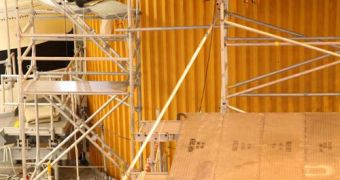The space shuttle Discovery is currently scheduled to take off in its STS-133 mission no earlier than February 3, and engineering teams at NASA are racing around the clock to ensure that the spacecraft is ready for the flight.
The orbiter is headed for the International Space Station (ISS), where it will deliver a new Multipurpose Logistics Module (MPLM) and the Robonaut 2 android, which was developed by NASA and General Motors.
Originally, the spacecraft was supposed to visit the station in early November 2010, but a series of glitches in a motor controller prevented mission controllers from allowing Discovery to take off.
Upon more detailed inspections, a number of cracks were found on the surface of the massive external fuel tank (EFT), the orange structure on which the shuttle is affixed.
The tank is used to carry the excess fuel the orbiter needs to achieve escape velocity, and also acts as a support for the twin solid rocket boosters (SRB) each shuttle uses to reach low-Earth orbit.
The cracks forced mission managers to delay the launch until December, when additional damage was identified on the EFT. NASA then decided to move the spacecraft back to the Vehicle Assembly Building (VAB), at the Kennedy Space Center (KSC), in Florida.
Discovery was therefore rolled off Launch Pad 39A, and taken back to the VAB atop the Crawler Transporter, the second-largest tracked vehicle in the world, Space reports.
Once back in the cavern of the VAB, the EFT was subjected to rigorous X-ray imaging tests, meant to detect surface and sub-surface cracks in the material covering the tank. Following the analysis, engineers began consolidating sections of the EFT.
KSC experts say that 34 of the 108 aluminum support beams making up the midsection of the EFT are currently being reinforced using additional pieces of aluminum. This region of the tank is the one that suffers most stress, and which is most prone to damage, during a regular launch.
Today, January 6, NASA officials are expected to meet up and discuss whether the same type of reinforcement is needed on the rest of the support beams making up the EFT.
Engineers estimate that the repair work will be completed on the shuttle and its tank this week, if mission controllers decide not to reinforce all the EFT segments. If the contrary decision is made, then repairs will be completed next week.
Before NASA allows Discovery to launch, a panel of experts will conduct a final verification of the shuttle and all of its components a few days before the launch.

 14 DAY TRIAL //
14 DAY TRIAL //